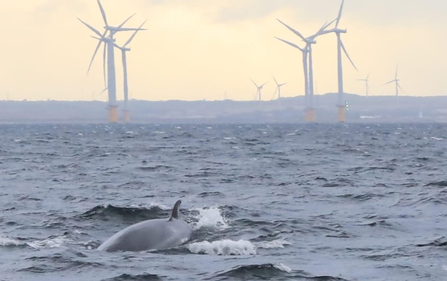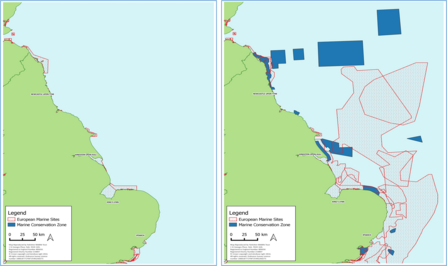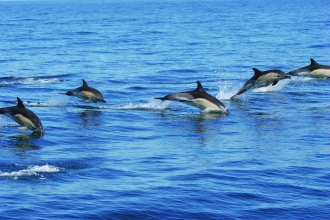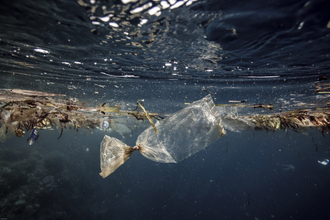The North Sea is groaning under the pressure of human impact
The iconic white Flamborough Cliffs rise from vibrant turquoise waters, adorned by wildflowers in the meadows above and home to thousands of nesting seabirds. But beneath the waves, something just as incredible is hidden.
Many do not realise that this white chalk stretches for 6km under the waves, creating one of the richest and most important marine habitats in the North Sea. This chalk is the basis for a vast world of marine life, from scuttling crabs and starfish to darting fish majestic whales, dolphins and porpoises.
But for over a century, unsustainable fishing and over-development have been destroying the incredible habitats that are the bedrock of healthy seas, literally ripping them up and tearing them apart. Once lost, it can take decades for nature to recover, and human disturbance makes the recovery impossible without protection.
We've been campaigning for over a decade to secure the protection our seas need, but we need your help to make it happen.

Kelp under the sea (c) Alexander Mustard
You can stop the exploitation of our seas for good.
What's the damage?

Ill-considered development
Above and below the waves, the North Sea is gridlocked with activity. Commercial developments are happening at a rate of knots, with little thought to the impact on the surrounding environment or sustainability for the future.
Installation of major infrastructure and resource exploration cause excessive levels of noise and damage the seabed, which is home, and a breeding and feeding ground, for so many species. What's more, essential migration and feeding routes are dangerous and difficult to navigate.

Tearing up the seabed
Bottom towed fishing gear is destroying our seabed. The huge metal teeth drag through the seabed, indiscriminately catching any creatures in their path and damaging or killing many others.
What was once a complex, rugged seabed reef - rich with sponge, sea fans and coral - has now been flattened to a plain of sand, gravel and mud with relatively little life.

Industrial-level fishing
Fishing is an important part of our economy, an essential and valued livelihood for coastal communities and part of our history. However, currently over half of the UK's fisheries are unsustainable.
Around the UK, supertrawlers are catching more than a sustainable level of fish. What's more, they're indiscriminately netting other species such as dolphins and harbour porpoise in the process.

Offshore windfarms
Renewable energy sources, such as windfarms help us to combat the climate crises, but the scale and rate at which these pieces of infrastructure are being installed is unprecedented.
Although they provide green energy, these structures can disturb the migration routes of both birds and fish, and create excessive levels of noise pollution and damage the seabed - a home, nursery area and feeding ground for many species. We are yet to understand the total impact these developments have on our marine wildlife.
The cumulative impact of all this activity is the slow death of our marine environment – devastated seabed, plummeting fish stocks and once common species now endangered.
But all is not lost, not yet...

A puffin (Fratercula arctica) swims underwater. Puffins spend most of their lives at sea and are excellent underwater swimmers, which is how they catch small fish, their main food. They swimming is rather robotic to watch, with discret flaps of their wings and jerky changes in direction. Photographed in July 2011, Farne Islands, Northumberland. England, UK. North Sea. - Alexander Mustard/2020VISION
We can turn the tide against exploitation
Sanctuaries at sea
Over the last decade we have championed the need for healthier marine ecosystems, fighting for better protection of our seas.
Through our science, advocacy and campaigning, we have secured a network of four new Marine Protected Areas (MPAs) within Yorkshire's seas.
It is now time to make sure these nature reserves at sea are not just lines on a map but real sanctuaries for our marine wildlife. We've already ensured the enhanced protection of Flamborough's existing MPA, where bottom-towed fishing gear is no longer permitted in large areas.
By working with other sea users and policy makers to inform how these areas should be managed, we can ensure our Marine Protected Areas are doing what they're meant to - providing wildlife with crucial protection and the chance to recover.

North Sea Marine Protected Areas within 2009 (on the left) and 2019 (on the right)

Our vision is that all activities at sea are sustainable
These activities will be carefully considered and only permitted once the assessment on our wildlife has been determined to be of low impact. We'll do this by:
- working more closely with legislators and policy makers who value the expertise of our marine specialists when considering all human activities within Marine Protected Areas.
- working with businesses to develop and innovate technology and systems that can be installed using low impact techniques, which we can advise upon to best protect our marine species.
Our efforts, alongside those of our partners, will create a North Sea Recovery Network; a joined-up system of protected precious wild places where our marine wildlife can thrive, and habitats have chance to replenish and restore.

Donate £12
£12 could helps us to equip our cetacean survey volunteers with essential ID guides
Donate £32
£32 could help train and equip citizen scientists to undertake critical whale and dolphin surveys
Donate £204
£204 could play for essential training and equipment for beach clean coordinators
(c) Simon Ward
Understanding our seas
In order to protect our seas from exploitation, we first need to understand as much as we can about them. Data on our our incredible marine wildlife is invaluable - where they are feeding, where they are breeding and how their behaviour is changing.
In partnership with SeaWatch Foundation, we recruit and train volunteers every year as citizen scientists, who conduct surveys of our whales, dolphins and porpoises up and down the Yorkshire coast.
By creating and building a sustainable legacy to protect and restore the wildlife in our seas, natural spectacles like tuna leaping from the waves and a seabed covered with a colourful mosaic of seagrass, oysters and kelp forests could be the reality for Yorkshire’s waters once again.
We need your help to protect our seas.
And finally...
Can you Give Seas a Chance by sharing our campaign on social media?
Thank you for your support!





